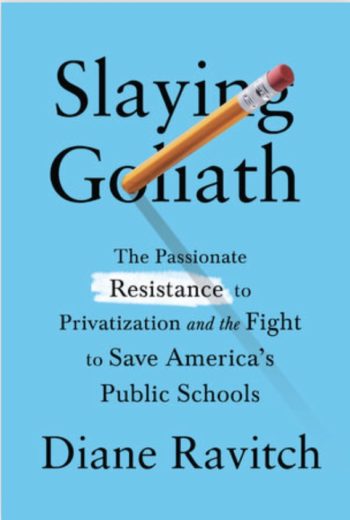By John Thompson.
Part Two of two.
Diane Ravitch’s Slaying Goliath: The Passionate Resistance to Privatization and the Fight to Save America’s Public Schools is the history of the rise and fall of test-driven, competition-driven school reform. As in her two previous, ground-breaking books, Ravitch changes the terms of debate over public education. She previously reframed the battle over the “Billionaires Boys Club” which drove “corporate reform,” and “privatization.” Ravitch now characterizes data-driven, choice driven reformers as “Disrupters,” and the grassroots anti-“Goliath” movement as the “Resisters.” She also tells the stories of that social movement, contrasting it with the faux-movement funded by the Disrupters.
The debacles produced by the Disrupters resulted from high-stakes testing, combined with competition with charters (and vouchers), as well as the hurried, untested, manner that they imposed value-added teacher evaluations; mass closures of schools; Common Core standards; behaviorist methods i.e. “No Excuses;” digital technology known as “personalized learning;” and expensive public relations campaigns that demonized teachers.
This second post will focus on Ravitch’s analysis of the research which predicted the defeat of accountability-driven, charter-driven policies. Perhaps the most striking pattern documented in Slaying Goliath is how they failed in the way that scholars and practitioners anticipated.
 Decades of Disruption-driven reform began with the false claim “that American education was failing and the only way to fix it was with standards, tests, competition, and accountability.” As Arne Duncan’s public relations officer and Walton-funded reformer Peter Cunningham said, “We measure what we treasure.”
Decades of Disruption-driven reform began with the false claim “that American education was failing and the only way to fix it was with standards, tests, competition, and accountability.” As Arne Duncan’s public relations officer and Walton-funded reformer Peter Cunningham said, “We measure what we treasure.”
Ravitch’s response was, “I was taken aback because I could not imagine how to measure what I treasure: my family, my friends, my pets, my colleagues, my work, the art and books I have collected.” And that foreshadows the victory of the Resistance over Goliath. Most educators, patrons, and students agree that children are more than a test score.
No Child Left Behind and the Race to the Top set impossible test score targets. They were based in large part on the weird idea that “no-excuses” behaviorist pedagogies could be quickly “scaled up,” providing poor children of color a ladder to economic equality. Drawing on the tradition of Edward Thorndike and B.F. Skinner, reformers “rigidly prescribed conditioning via punishments and rewards.” Previewing their fatal flaw, Ravitch observes, “Behaviorists, and the Disrupters who mimic them today, lack appreciation for the value of divergent thinking, and the creative potential of variety. And they emphatically discount mere ‘feelings.’”
When educators resisted, corporate reformers became livid and doubled down on the punitive. Perhaps their worst debacle was using value-added teacher evaluations to hold each individual educator accountable for test score growth. It combined inappropriate test outputs with an unreliable and invalid algorithm, the VAM, as a club to enforce compliance. In the short run, it forced educators, who had previously tried to keep their heads down and “monkey wrench” testing mandates to join patrons and students in the Resistance. By 2018, however, pent up anger exploded as teacher strikes spread across the nation.
Today, many or most of Goliath’s coalition have become disenchanted with standardized testing, but their Disruption model can’t function without it. Few have gone as far as Paymon Rouhanifard, the former Camden superintendent who abolished report cards after listening to complaints, and denounced standardized testing as he left the job.
The more common path is to spin their punitive tests as “personalized” learning, and their incentives and disincentives as the “portfolio model.” As Ravitch explains, “A portfolio district is one where the local board (or some entity operating in its stead) acts like a stockbrokerage, holding onto winners (schools with high test scores) and getting rid of losers (schools with low test scores).”
As was also predicted by Campbell’s Law, test-driven accountability (made more intimidating by the dual threat of test-driven competition with charters) led to corruption. The cheating was far greater than just the scandals where adults erased and changed bubble-in answers. Graduation rates were easy to manipulate. For instance, NPR reported a “heartwarming story” in 2017 about a school with 100% graduation rate. A subsequent FBI investigation and a district audit found 1/3rd of the school’s graduates lacked credits and only 42% were on track to graduation.
And that leads to the corruption associated with school choice. Today’s Disrupters seem to be doubling down on charters to drive transformative change. As explained in a previous post, in 1988 Al Shanker saw charters as a path towards innovation. Within two years, however, the promise of win-win experimentation started to be undermined when conservative reformers Terry Moe and John Chubb claimed “choice is a panacea.”
In this case, it was choice-advocate Paul Peterson who predicted the political future. Charters didn’t take off because of the balanced approach of Shanker, but because reformers “radicalized” the concept. And, of course, there was plenty of big bucks available for pushing their radical but false narrative.
Within a decade, a shocking number of non-educators had been convinced by Goliath’s spinsters that the KIPP’s behaviorist model could be scaled up. As Slaying Goliath explains, “The biggest innovation in the charter sector was the invention of ‘no-excuses’ schools.” It took nearly another decade for policy makers to accept the fact that charters get average results except for those with high attrition.” And it took nearly as long to reveal the much greater down sides of charters.
Ravitch notes that since 1994 the U.S. “doled out” $4 billion for starting new charters, with 1/3rd failing, and with $1 billion lost to “’start-ups’ that never got off the ground.” Charter growth exploded with RttT, and its hypothesis that no-excuses schools could retain the highest-challenge students and lead them out of poverty. Charter growth began to decline in 2012–13, and by 2017, reformers admitted charter growth was “flat-lining.” (One reformer said this is partially due to the “slowed growth of TFA.”)
Since Secretary of Education Betsy DeVos was a driver of Michigan’s choice movement, it is noteworthy that that state was 28thin 4th grade reading in 2003 (to take just one NAEP score example.) In 2015 it was 41st. Florida is touted as a victory for charters, but Integrity Florida found that 50% were for-profit charters, and 400 charters had closed over two decades. The majority of Florida’s “F” schools were charters. Since Slaying Goliath was published, “the Orlando Sentinel reported that 156 private religious schools participating in Florida’s [voucher] program ‘have policies that say gay and transgender students can be denied enrollment or expelled or that explain the school opposes their sexual orientation or gender identity on religious grounds.’”
Arizona is also promoted as a choice success story by those who ignore the Center for Media and Democracy’s documentation of an “epidemic of fraud, waste, and mismanagement.” The Grand Canyon Institute found 3/4ths of charters in Arizona engaged in “related-party transactions, in which the charters were doing business with its owners, their family members, or board members.”
As Ravitch explains, “charter schools are as likely to close as are any other businesses, such as shoe stores, bookstores, and restaurants.” And, “The backlash against privatization grows stronger with every scandal.”
Slaying Goliath notes that without huge subsidies (currently at $600 million per year) from the federal government and edu-philanthropies, especially the Walton Foundation, “there would be few charters.” So, why do the billionaires kept investing “dark money” contributions in elections such as Massachusetts’ “Yes 2” charter expansion campaign? Why do they keep investing in their expensive “hobby”?
At minimum, even the billionaires should agree with Ravitch’s conclusion that:
Charter schools should be authorized only by their host districts. They should be operated by educators, not entrepreneurs. They should meet the needs that those districts cannot fill. They should hire only certified professionals. They should be subject to the same laws, regulations, and ethical standards.
It would be great if they would listen to her other advice, “Philanthropies should respect the sound principle of giving to meet needs instead of giving to impose their ideas and take control of others.”
Regardless of whether we’re discussing high-stakes testing, charter expansion, or the other pet theories, we should all heed Ravitch’s most important lesson of the past few decades is that “Reform doesn’t mean reform. It means mass demoralization, chaos, and turmoil. Disruption does not produce better education.”
Slaying Goliath celebrates a great victory for public education and democracy. However, Ravitch reminds us that the Disrupters are still threatening. She compares today’s danger to that which faced a man who decapitated a rattlesnake but who nearly died after being bitten by the detached head.
So, we can’t lower our guard until the principles that inspired the Resistance are safe in our schools.
What do you think? Will Goliath finally listen to Diane Ravitch? Where do we go from here?
Dr. John Thompson is an award-winning historian and an award-winning inner-city teacher. Now retired, he is the author of A Teacher’s Tale: Learning, Loving and Listening to Our Kids, which is being updated to be less academic and restore more students’ stories, as well as updating legal history research from the 1980s to 1990s.






Leave a Reply